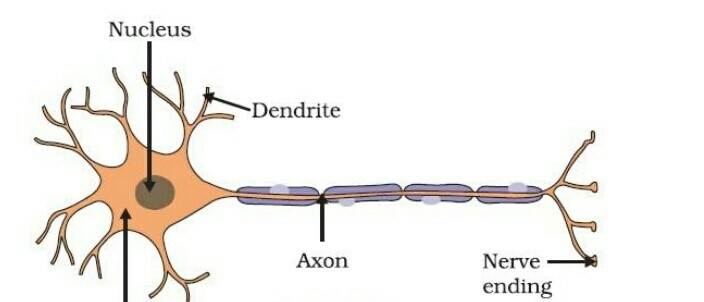Science
(www.olympiadsuccess.com)
Chapter 8: Cell - Structure and Functions
Class: VIII
NCERT Solutions
Question 1
Indicate whether the following statements are True (T) or False (F).
(a) Unicellular organisms have one-celled body. (T/F)
(b) Muscle cells are branched. (T/F)
(c) The basic living unit of an organism is an organ. (T/F)
(d) Amoeba has irregular shape. (T/F)
Answer 1
(b) Muscle cells are branched. (False)
(c) The basic living unit of an organism is an organ. (False)
(d) Amoeba has irregular shape. (True)
Question 2
Make a sketch of the human nerve cell. What function do nerve cells perform?
Answer 2
The nerve cell receives and transfers messages, thereby helping to control and coordinate the working of different parts of the body.

Cell Body
Nerve Cell
Question 3 Write short notes on the following:
(b) Nucleus of a cell
Answer 3
The jelly-like substance between the nucleus and the cell membrane is called cytoplasm. Various cell organelles like ribosomes, mitochondria etc. are suspended inside cytoplasm. It helps exchange and storage of substances among cell organelles. Most of the metabolic activities occur inside cytoplasm.

The central dense round body in the centre is called the nucleus. It is an important component of the living cell. It is generally spherical and located in the centre of the cell. It can be stained and seen easily with the help of a microscope. Nucleus is separated from the cytoplasm by a membrane called the nuclear membrane. This membrane is also porous and allows the movement of materials between the cytoplasm and the inside of the nucleus. A smaller spherical body in the nucleus, is called the nucleolus. Nucleus also contains thread-like structures called chromosomes. These carry genes and help in inheritance or transfer of characters from the parents to the offspring.
Question 4
Which part of the cell contains organelles?
Answer 4
Cytoplasm, gelatinous fluid inside a cell contains various organelles like mitochondria, Golgi bodies, ribosomes etc.
Question 5
Make sketches of animal and plant cells. State three differences between them.
Answer 5
|
S.No |
Part |
Plant Cell |
Animal Cell |
|
1. |
Cell wall |
Present |
Absent |
|
2. |
Centrosomes |
Absent |
Present and helps in cell division |
|
3. |
Plastids |
Present |
Absent |
|
4. |
Vacuole |
Large Vacuole |
Small Vacuole or Absent |

Question 6
State the difference between eukaryotes and prokaryotes.
Answer 6
Examples: Bacteria and blue green algae.
Examples: Onion cells and cheek cells.
Question 7
Where are chromosomes found in a cell? State their function.
Answer 7
Chromosomes are found in the nucleus of the cell. These carry genes and help in inheritance or transfer of characters from the parents to the offspring.
Question 8
‘Cells are the basic structural units of living organisms’. Explain.
Answer 8
Both, bricks in a building and cells in the living organisms, are basic structural units. All basic functions for the organism survival take place inside cells. As bricks assemble to make a building, cells assemble to make the body of every organism. A group of cells form a tissue which performs a specific function. A group of tissue forms an organ and in the same way a group of organs form an organism. That is why cells are considered as the basic structural units of living organisms.


Question 9
Explain why chloroplasts are found only in plant cells?
Answer 9
Chloroplasts are found in plant cells only because chloroplasts contain chlorophyll which is essential for photosynthesis. Chlorophyll traps cell energy and use it to prepare food for plants.
Question 10
Complete the crossword with the help of clues given below:
Across
Down

Answer 10
Across
Down

Yearlong program for Olympiads preparation & to build necessary skills for future.
Explore More
Time to mark your calendar with the upcoming Olympiads exam schedule.
Explore More
Take your Olympiad preparation to next-level by taking LIVE Classes.
Explore More
Assess your performance by taking topic-wise and full length mock tests.
Explore More
Online tuitions for international compeitions like SASMO, SEAMO, etc for Grades 1-11.
Explore More